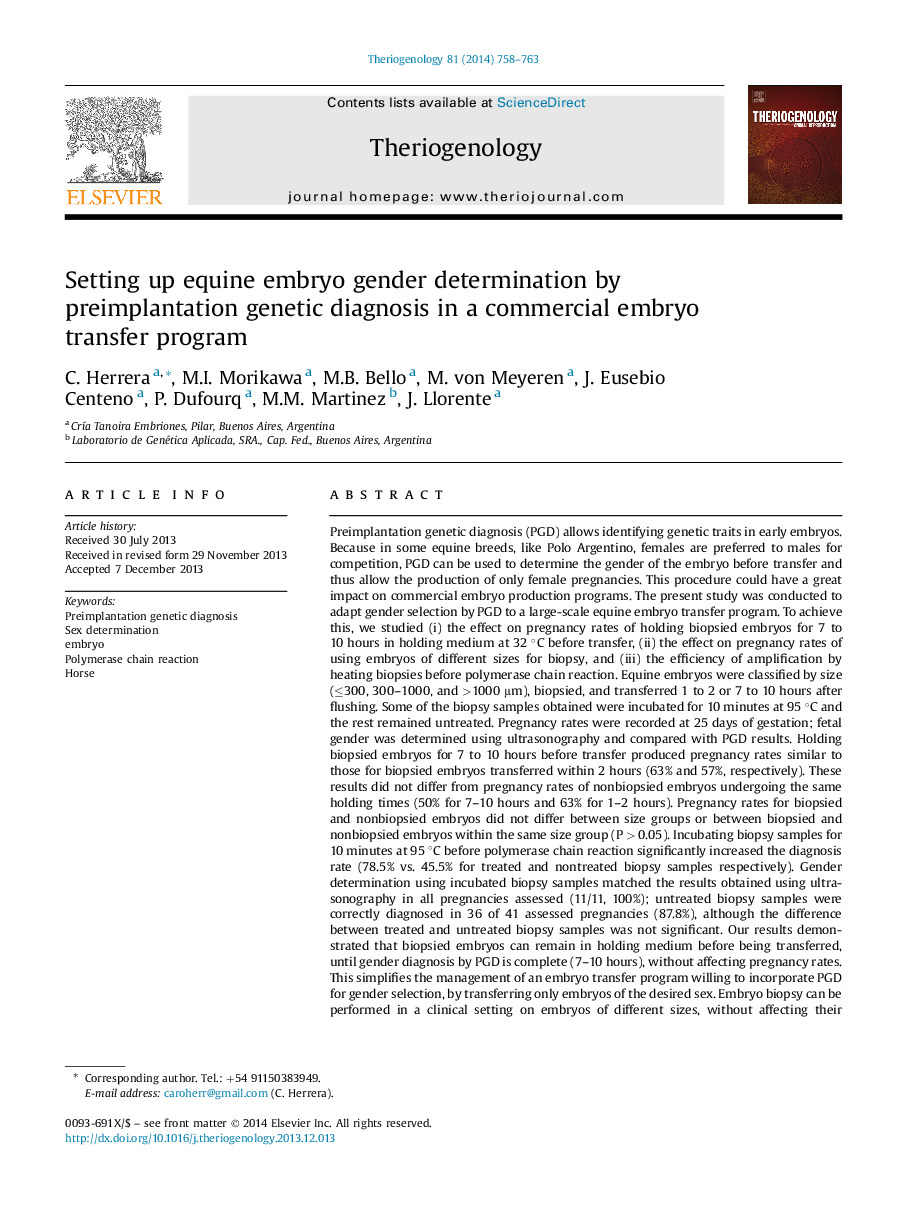| کد مقاله | کد نشریه | سال انتشار | مقاله انگلیسی | نسخه تمام متن |
|---|---|---|---|---|
| 10894112 | 1082256 | 2014 | 6 صفحه PDF | دانلود رایگان |
عنوان انگلیسی مقاله ISI
Setting up equine embryo gender determination by preimplantation genetic diagnosis in a commercial embryo transfer program
ترجمه فارسی عنوان
تعیین جنسیت جنین زنبور عسل با استفاده از تشخیص ژنتیکی قبل از تکامل در یک برنامه انتقال جنین تجاری
دانلود مقاله + سفارش ترجمه
دانلود مقاله ISI انگلیسی
رایگان برای ایرانیان
کلمات کلیدی
تشخیص ژنتیکی قبل از انکشاف، تعیین جنسیت، جنین، واکنش زنجیره ای پلیمریزاسیون، اسب،
موضوعات مرتبط
علوم زیستی و بیوفناوری
علوم کشاورزی و بیولوژیک
علوم دامی و جانورشناسی
چکیده انگلیسی
Preimplantation genetic diagnosis (PGD) allows identifying genetic traits in early embryos. Because in some equine breeds, like Polo Argentino, females are preferred to males for competition, PGD can be used to determine the gender of the embryo before transfer and thus allow the production of only female pregnancies. This procedure could have a great impact on commercial embryo production programs. The present study was conducted to adapt gender selection by PGD to a large-scale equine embryo transfer program. To achieve this, we studied (i) the effect on pregnancy rates of holding biopsied embryos for 7 to 10 hours in holding medium at 32 °C before transfer, (ii) the effect on pregnancy rates of using embryos of different sizes for biopsy, and (iii) the efficiency of amplification by heating biopsies before polymerase chain reaction. Equine embryos were classified by size (â¤300, 300-1000, and >1000 μm), biopsied, and transferred 1 to 2 or 7 to 10 hours after flushing. Some of the biopsy samples obtained were incubated for 10 minutes at 95 °C and the rest remained untreated. Pregnancy rates were recorded at 25 days of gestation; fetal gender was determined using ultrasonography and compared with PGD results. Holding biopsied embryos for 7 to 10 hours before transfer produced pregnancy rates similar to those for biopsied embryos transferred within 2 hours (63% and 57%, respectively). These results did not differ from pregnancy rates of nonbiopsied embryos undergoing the same holding times (50% for 7-10 hours and 63% for 1-2 hours). Pregnancy rates for biopsied and nonbiopsied embryos did not differ between size groups or between biopsied and nonbiopsied embryos within the same size group (P > 0.05). Incubating biopsy samples for 10 minutes at 95 °C before polymerase chain reaction significantly increased the diagnosis rate (78.5% vs. 45.5% for treated and nontreated biopsy samples respectively). Gender determination using incubated biopsy samples matched the results obtained using ultrasonography in all pregnancies assessed (11/11, 100%); untreated biopsy samples were correctly diagnosed in 36 of 41 assessed pregnancies (87.8%), although the difference between treated and untreated biopsy samples was not significant. Our results demonstrated that biopsied embryos can remain in holding medium before being transferred, until gender diagnosis by PGD is complete (7-10 hours), without affecting pregnancy rates. This simplifies the management of an embryo transfer program willing to incorporate PGD for gender selection, by transferring only embryos of the desired sex. Embryo biopsy can be performed in a clinical setting on embryos of different sizes, without affecting their viability. Additionally, we showed that pretreating biopsy samples with a short incubation at 95 °C improved the overall efficiency of embryo sex determination.
ناشر
Database: Elsevier - ScienceDirect (ساینس دایرکت)
Journal: Theriogenology - Volume 81, Issue 5, 15 March 2014, Pages 758-763
Journal: Theriogenology - Volume 81, Issue 5, 15 March 2014, Pages 758-763
نویسندگان
C. Herrera, M.I. Morikawa, M.B. Bello, M. von Meyeren, J. Eusebio Centeno, P. Dufourq, M.M. Martinez, J. Llorente,
